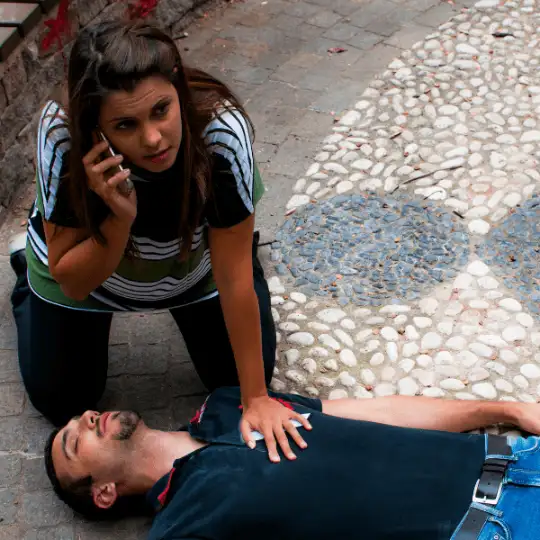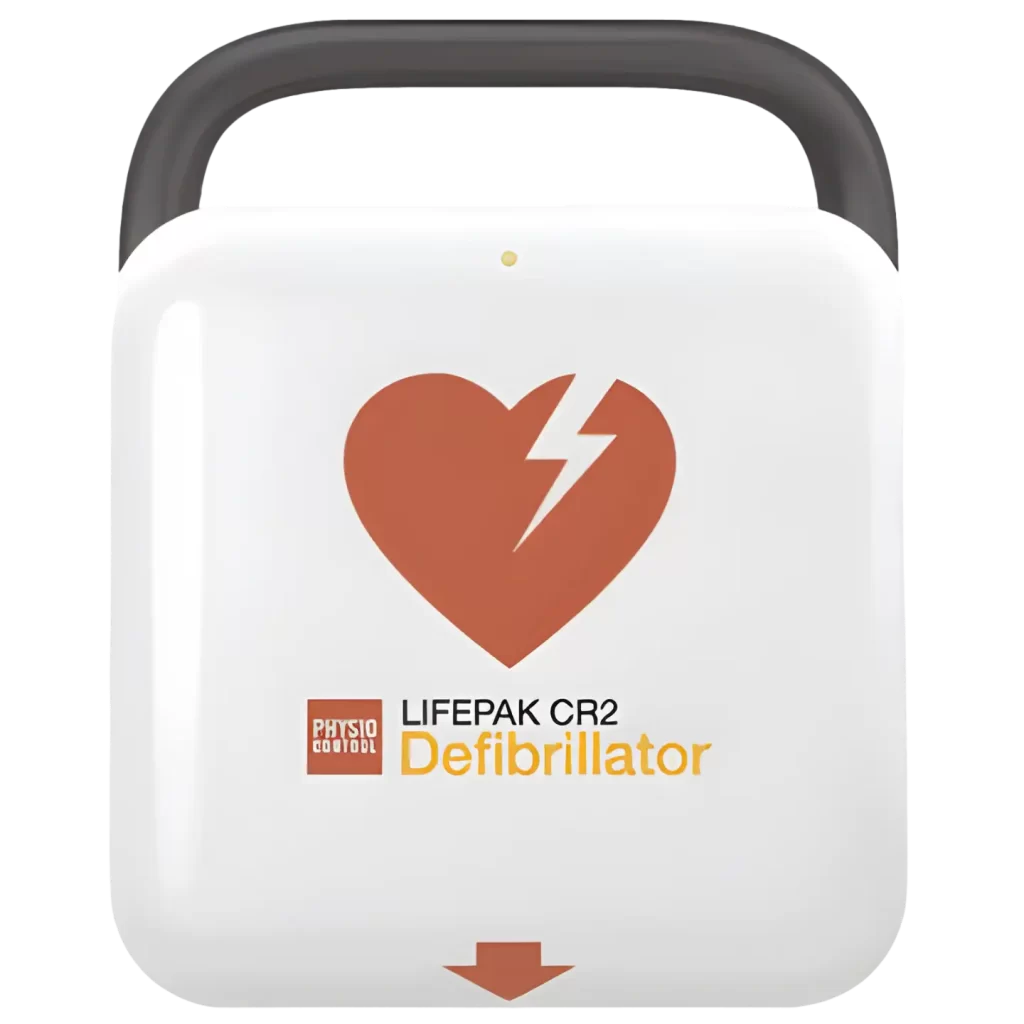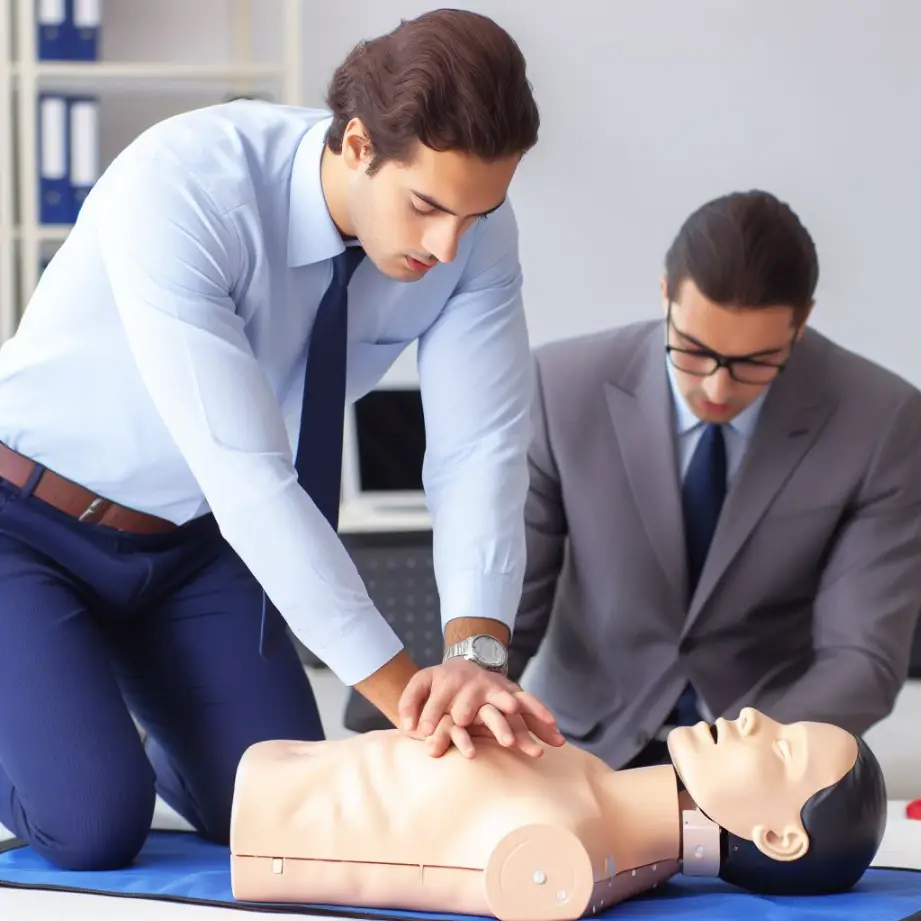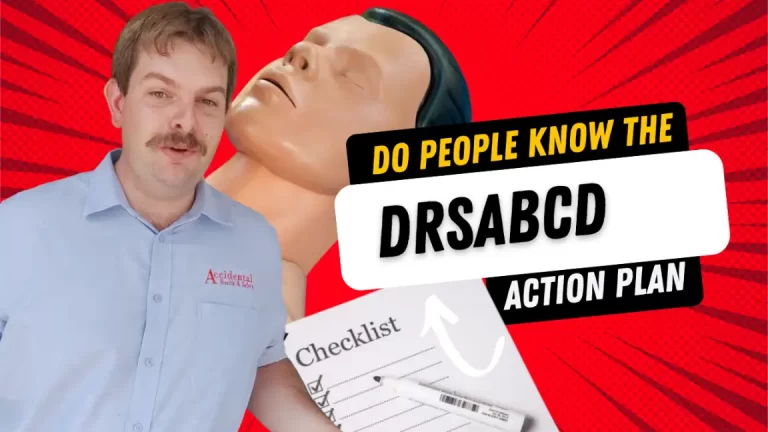The Chain of Survival: Life-Saving Links for First Aid and CPR

Did you know that in Australia, only 8% of people who suffer cardiac arrest outside of a hospital survive? It’s a shocking statistic. We need to do better. When someone’s life is on the line, every second counts. That’s where the Chain of Survival comes in. The Chain of Survival is a set of guiding principles first aiders need to remember when trying to help someone. If we use it, you’ll be amazed how much higher the odds of survival are In this blog post, we’ll explore each link in the Chain of Survival and show you how to use them to improve the chances of survival for someone experiencing a medical emergency.
Chain of Survival First Aid Steps

- Early Access: The first step in the Chain of Survival is to recognize an emergency situation and activate the emergency response system by calling 000 (Australia’s emergency number) immediately. Getting help as soon as possible is critical, as it can mean the difference between life and death.
- Early CPR: The second step is to begin CPR as soon as possible. CPR (cardiopulmonary resuscitation) involves providing chest compressions and rescue breaths to keep blood and oxygen flowing to the brain and other vital organs. Without CPR, brain damage can occur within minutes of cardiac arrest. By starting CPR early, you can buy time until advanced medical help arrives.
- Early Defibrillation: The third step is to use a defibrillator to shock the heart and restore its normal rhythm. Defibrillators are portable devices that can be used to deliver an electrical shock to the heart. They are becoming more common in public places like shopping centers, airports, and sporting venues, and can be used by anyone, even those without medical training.
- Early Advanced Care: The final step in the Chain of Survival is to provide advanced care, including medications and advanced airway management, to people who require further treatment in a hospital setting.
Lets dig a little deeper on each point.
Early Access
In many emergency situations, time is of the essence, and every second counts. That’s why it’s essential to call for help as soon as possible by dialing 000 (Australia’s emergency number).
Seem’s easy right? Not always. Every year, there are stories of people who fail to call for help in an emergency situation. In some cases, people assume that someone else will call for help, while in others, people are simply unsure if the situation warrants an emergency response. However, in emergency situations, it’s always better to be safe than sorry. Remember, if you’re not sure if it’s an emergency, call 000 anyway.

What if you have no signal? If you have no network access 000 will try to find a tower from other networks such as Telstra, Optus Vodafone to put you through. Even if you have no or limited signal, you can often still call for help in an emergency. If not, you’ll need to get to signal, or send someone to do so.
Above all, it’s essential not to have a “she’ll be right attitude” when it comes to emergency situations. Delaying or avoiding calling for help can have severe consequences and can result in unnecessary suffering or loss of life. By calling for help early, you can provide the person in need with the best chance of survival and increase the likelihood of a positive outcome.
Early CPR
The second link in the Chain of Survival is early CPR. We’ve all seen CPR in movies, pushing on the chest and giving breaths helps circulate oxygenated blood to the brain and vital organs to keep them alive so they can be resuscitated.
Why is it a priority to do it as early as possible? Without CPR, the brain can begin to suffer damage within just a few minutes of cardiac arrest. After 10 minutes without oxygen, the chances of survival are extremely low.
Effective CPR can double or even triple a person’s chances of survival. There are three key tips for great CPR that anyone can remember: 1) Make sure you push hard enough, 2) Push at the correct rate of 100-120 beats per minute, and 3) Make sure your hands are in the center of the chest
To become a CPR expert, check out our ultimate guide to DRSABCD. This stands for Danger, Response, Airway, Breathing, Compression, and Defibrillation. By following these steps, you can provide effective CPR and help improve the chances of survival for someone experiencing a cardiac arrest.
Remember, in an emergency situation, every second counts. By providing early CPR, you can help to buy time until advanced medical help arrives. Don’t hesitate to act – the life you save could be someone you love.
Early Defibrillation

Have you ever seen a defibrillator in a public place like a shopping center or airport? These portable devices can be real lifesavers in emergency situations. The third link in the Chain of Survival is early defibrillation, which involves using a defibrillator to deliver an electrical shock to the heart and restore its normal rhythm.
Using a defibrillator is easier than you might think. Modern defibrillators are designed to be user-friendly, and they will even provide voice prompts to guide you through the process. By using a defibrillator as soon as possible, you can help to increase a person’s chances of survival significantly.
You might be wondering, “Why not just wait for an ambulance to arrive and let them handle the defibrillation?” While it’s true that EMS personnel are trained to provide advanced medical care but time is critical in emergency situations like cardiac arrest. The longer a person goes without treatment, the lower their chances of survival.
One study showed that when a defibrillator shock was applied within 3 minutes more than 70% of cardiac arrest victims survived! A huge improvement from the 8% that currently survive. What ambulance could arrive and deliver a shock within 3 minutes? Obviously, it’s so much better for First Aiders to use a defibrillator if one is available.
Early Advanced Care
The final link in the Chain of Survival is early advanced care, which involves providing further medical treatment to the person who requires it. This could include medications, advanced airway management, or other interventions that require a hospital or ambulance.
While the focus of the Chain of Survival is on cardiac arrest, it’s important to remember that other emergencies may also require early advanced care. For example, in the case of a stroke, it’s important to act fast and get medical help as soon as possible to minimize the damage to the brain. Similarly, if someone has been bitten by a snake or spider, quick medical attention is essential to improve the outcome.
Chain of Survival Wrap up
The Chain of Survival is a set of guiding principles that can help you to respond effectively to an emergency situation. By following the four links – early access, early CPR, early defibrillation, and early advanced care – you can help to improve the chances of survival for someone experiencing a medical emergency.
Remember that every second counts in an emergency, so don’t hesitate to act. Call for help as soon as possible, start CPR if needed, use a defibrillator if available, and provide advanced care as soon as possible.
By learning about the Chain of Survival and how to respond in an emergency, you can be better prepared to help save a life. Take the time to learn CPR, familiarize yourself with the DRSABCD guide, and locate the nearest defibrillator in your community. You never know when you may need to use these life-saving skills!

Hey there! I’ve been a first aider since 2012, eventually becoming a first aid trainer and writer. When I’m not writing first aid articles you can find me birding and listening to jangle pop.







